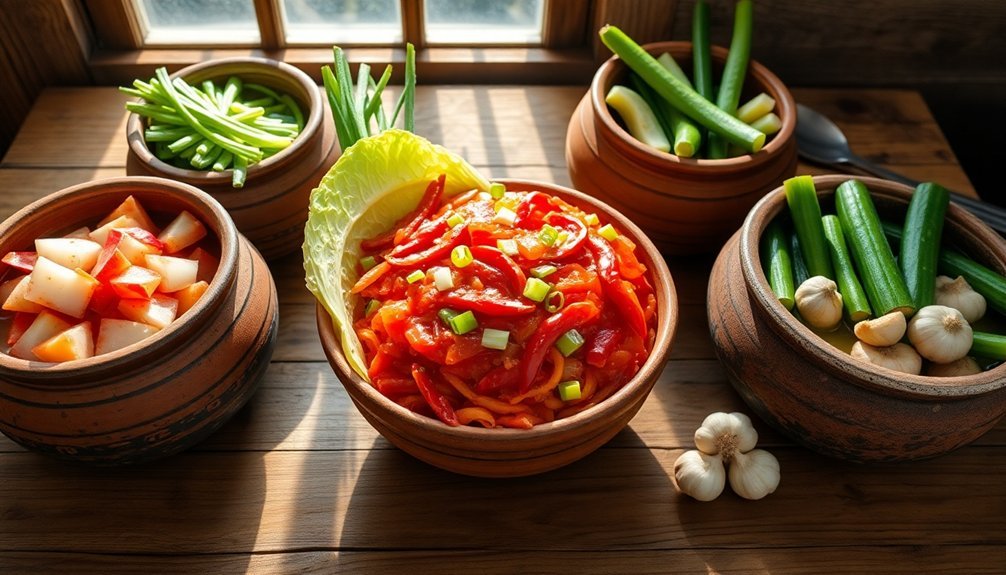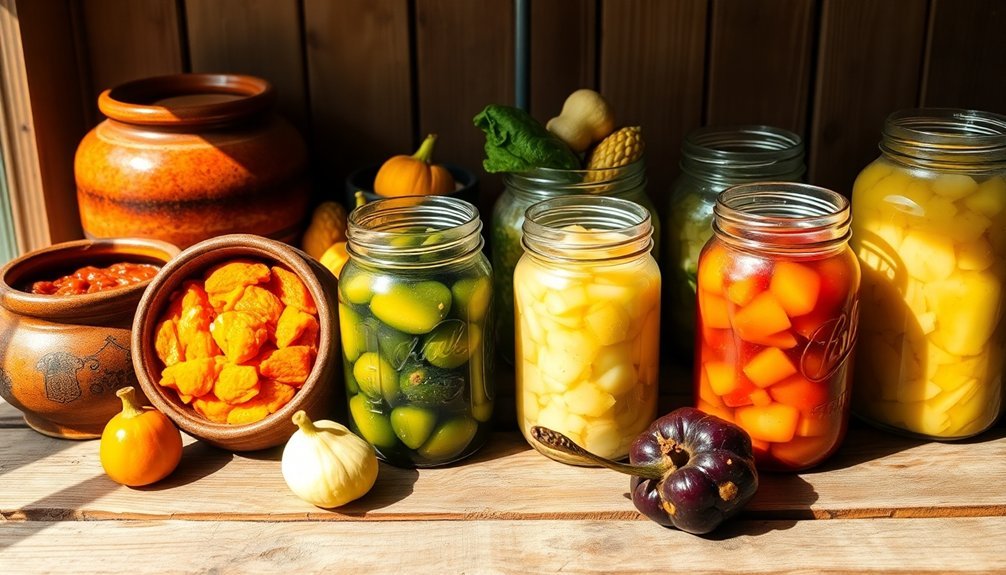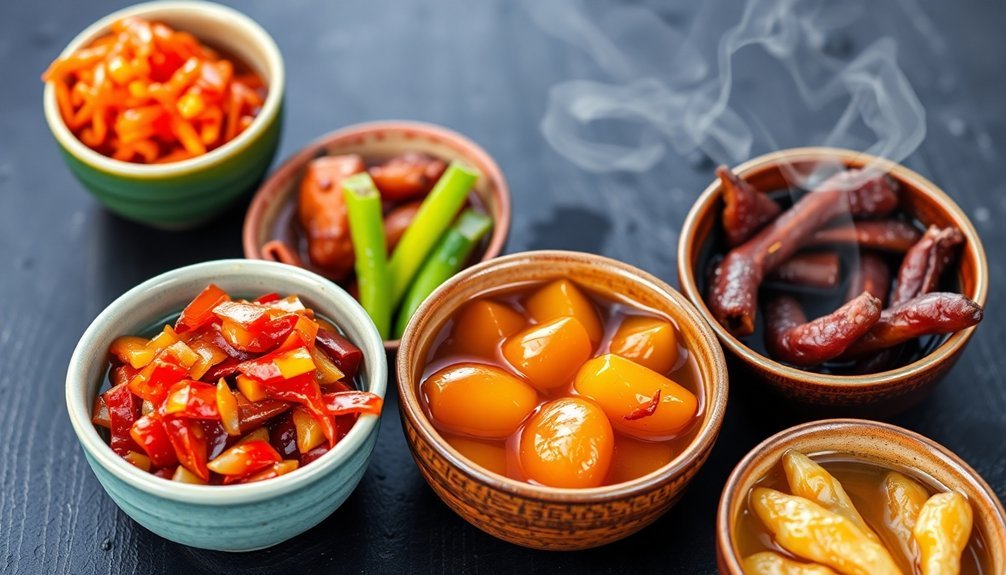You'll discover an incredible world of flavor and health benefits with these five essential Asian fermented vegetables. Start with Korea's iconic kimchi, a spicy and tangy cabbage dish packed with probiotics. Japan's tsukemono offers delicate pickled vegetables that perfectly complement any meal. China's paocai brings complexity through its salt-brined vegetables enhanced with aromatic spices. From the Himalayas, try gundruk, a unique fermented leafy green preparation rich in nutrients. Finally, explore the diverse world of achaar, featuring oil-preserved vegetables and bold spice combinations. These time-honored traditions hold centuries of culinary wisdom waiting to be explored.
Korean Kimchi's Rich Heritage

Preserving Korea's culinary heritage, kimchi stands as one of the world's most celebrated fermented foods, with roots stretching back to the Three Kingdoms period (57 BCE – 668 CE). The Goguryeo people mastered fermentation techniques, and you'll find early mentions of fermented vegetables in the historical text Samguk Sagi. Traditional fermentation takes place in earthenware vessels called onggi, buried underground to maintain optimal temperature.
You might be surprised to learn that kimchi's signature red color is relatively modern. While today's kimchi gets its distinctive hue from chili peppers, these weren't widely used until the 19th century. Instead, early versions relied on ingredients like garlic, ginger, and salted fish for flavoring.
The tradition of making kimchi, known as Kimjang, is so significant that UNESCO recognizes it as an Intangible Cultural Heritage. When you participate in Kimjang, you're joining a practice that strengthens family bonds and community ties, as households often share their kimchi with neighbors.
The preparation follows nature's rhythm, with different ingredients used throughout the year. You'll find various types, from the common napa cabbage kimchi to specialized versions like *chonggak-kimchi* and *oi-sobagi*, each recipe often passed down through generations as precious family heritage.
Japanese Tsukemono Through Time
Like their Korean neighbors, Japanese cooks have mastered the art of fermented vegetables through tsukemono, a pickling tradition that spans over two millennia.
You'll find this preservation technique rooted in ancient Chinese and Korean influences, which eventually evolved into a distinctly Japanese culinary art form during the Yayoi period.
From humble household beginnings to today's commercial production, tsukemono's preparation methods have diversified to include various techniques. The traditional process creates sour and salty notes that perfectly complement Japanese meals.
You can create these pickled delights through salt-based methods, rice bran fermentation (nukazuke), or by using traditional Japanese seasonings like soy sauce and miso.
Here's why tsukemono remains central to Japanese cuisine:
- It's an essential component of traditional ichiju-sansai meals, providing vital flavor balance
- You'll benefit from its probiotic properties and digestive-aiding qualities
- It embodies the mottainai principle of reducing food waste
- It preserves family traditions through generations of handed-down recipes
Whether you're sampling crisp pickled cucumbers, tangy takuan, or complex fukujin-zuke, you're experiencing a culinary tradition that's deeply woven into Japan's gastronomic fabric.
Chinese Paocai Preservation Methods

The art of paocai preparation demands meticulous attention to both ingredient preparation and environmental control.
You'll need to start by washing and cutting your vegetables into bite-sized pieces, then thoroughly air-drying them to remove all moisture. Common choices include radish, carrot, cowpea, and cabbage, which you'll place in a completely dry pickling jar.
Your brine is essential for successful fermentation. Create a 6-8% salt solution by boiling water and salt together, then cooling it to room temperature. The brine's composition helps create a beneficial bacteria environment that promotes gut health.
You'll want to enhance the brine with seasonings like ginger, chili, Sichuan pepper, and garlic, plus Chinese rock sugar and white liquor. If you've got aged pao cai brine, use it to jumpstart the fermentation process.
You'll need to guarantee anaerobic conditions using a water-sealed jar, which allows gases to escape while preventing oxygen from entering.
Let your vegetables ferment at room temperature for 1-2 days for a light pickle, or 5-7 days for fuller fermentation. Once you've achieved your desired sourness, store the jar in the fridge.
With proper maintenance, you can reuse the brine for years, creating generations of flavorful paocai.
Himalayan Gundruk Traditional Practices
Fermentation mastery in the Himalayas comes alive through gundruk, a traditional method that transforms leafy vegetables into a tangy, nutrient-rich preserved food. You'll find this unique preservation technique primarily using leaves from mustard, radish, and cauliflower plants native to the region.
The process begins with wilting fresh leaves for 1-2 days before gentle crushing and tight packing into earthen pots. Over 15-22 days, natural fermentation creates beneficial lactic acid bacteria, breaking down complex sugars and improving digestibility. After fermentation, you'll need to dry the gundruk in the sun for 2-4 days.
Here's why you should incorporate gundruk into your diet:
- It's incredibly low in calories (19 calories per cup) while providing 2g of fiber
- You'll get essential nutrients like calcium, iron, and potassium
- The fermentation process creates natural probiotics that support gut health
- It's versatile – use it in soups, pickles, or sautéed dishes
When you're ready to use gundruk, simply rehydrate it in water for about 10 minutes, remove any tough stems, and incorporate it into your favorite recipes. The fermented aroma really comes alive when you sauté it in oil before adding other ingredients.
Regional Achaar Making Techniques

Moving from the mountains of Nepal to the diverse regions of Asia, achaar making showcases distinct techniques that vary greatly by location.
In North India, you'll find a meticulous process involving air-dried garlic and chilies, combined with roasted spice blends of fennel, fenugreek, and mustard seeds. The mixture is preserved in mustard oil and vinegar, allowing flavors to mature over time without immediate fermentation.
Southeast Asian techniques differ markedly, incorporating unique ingredients like lemongrass, galangal, and belacan. You'll notice they create a distinctive spice paste that's cooked in oil before being combined with nuts and vinegar-blanched vegetables, typically stored in large 3-4 L jars.
If you're interested in fermented achaar, you'll need to focus on proper container selection – glass jars with wide mouths work best.
The process involves creating a coarse spice mixture and submerging vegetables in a saltwater brine solution. You'll want to use fermentation weights to keep vegetables submerged and shake the jar daily to distribute flavors.
After three days, you can start tasting to check the fermentation progress.
Frequently Asked Questions
Can I Mix Different Asian Fermented Vegetables in the Same Container?
Yes, you can mix different Asian vegetables in the same container. Just make sure they're cut to similar sizes and properly submerged in brine. You'll get complex flavors as they ferment together.
Why Do Some Fermented Vegetables Turn Softer While Others Stay Crunchy?
Your fermented vegetables' texture varies based on salt levels, fermentation time, temperature, and vegetable quality. If you don't maintain proper conditions or use overripe produce, they'll turn soft instead of staying crunchy.
Is It Safe to Eat Fermented Vegetables During Pregnancy?
You can safely eat commercially produced fermented vegetables during pregnancy. They'll provide gut health benefits, but avoid homemade versions. Stick to trusted brands and start with small amounts if they're new to you.
What Causes the White Film on Top of Fermenting Vegetables?
The white film you're seeing is likely kahm yeast, caused by insufficient acidity, low salt levels, warm temperatures, or poor hygiene. While it's not harmful, you'll want to maintain proper fermentation conditions to prevent it.
Can I Reduce Saltiness in Fermented Vegetables After They're Done?
Yes, you can reduce saltiness after fermentation. Try rinsing your fermented veggies under cold water, mixing them with fresh vegetables, or incorporating them into other dishes. Be gentle when rinsing to preserve flavors.
In Summary
You've explored five remarkable fermented vegetables that showcase Asia's mastery of preservation. Whether you're drawn to kimchi's fiery kick, tsukemono's delicate flavors, paocai's unique tang, gundruk's earthy notes, or achaar's complex spices, these traditional foods offer more than just taste – they're packed with probiotics and cultural significance. Don't miss out on these time-tested delicacies that'll transform your culinary experience and boost your gut health.





Leave a Reply